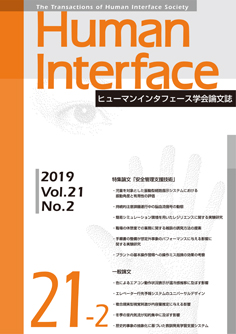Volume 21, Issue 2
Displaying 1-11 of 11 articles from this issue
- |<
- <
- 1
- >
- >|
Papers on Special Issue Subject “Safety Management Support Technology”
-
Article type: Original Paper
2019Volume 21Issue 2 Pages 141-150
Published: May 25, 2019
Released on J-STAGE: May 25, 2019
Download PDF (1622K) -
Article type: Short Note
2019Volume 21Issue 2 Pages 151-154
Published: May 25, 2019
Released on J-STAGE: May 25, 2019
Download PDF (1405K) -
Article type: Original Paper
2019Volume 21Issue 2 Pages 155-168
Published: May 25, 2019
Released on J-STAGE: May 25, 2019
Download PDF (2357K) -
Article type: Original Paper
2019Volume 21Issue 2 Pages 169-186
Published: May 25, 2019
Released on J-STAGE: May 25, 2019
Download PDF (2532K) -
Article type: Original Paper
2019Volume 21Issue 2 Pages 187-198
Published: May 25, 2019
Released on J-STAGE: May 25, 2019
Download PDF (2219K) -
Article type: Short Note
2019Volume 21Issue 2 Pages 199-202
Published: May 25, 2019
Released on J-STAGE: May 25, 2019
Download PDF (1410K)
Papers on General Subjects
-
Air conditioner status of operation as indicated by color modulates transition of thermal perceptionArticle type: Original Paper
2019Volume 21Issue 2 Pages 203-210
Published: May 25, 2019
Released on J-STAGE: May 25, 2019
Download PDF (1321K) -
Article type: Original Paper
2019Volume 21Issue 2 Pages 211-224
Published: May 25, 2019
Released on J-STAGE: May 25, 2019
Download PDF (6196K) -
Article type: Original Paper
2019Volume 21Issue 2 Pages 225-234
Published: May 25, 2019
Released on J-STAGE: May 25, 2019
Download PDF (1045K) -
Article type: Original Paper
2019Volume 21Issue 2 Pages 235-244
Published: May 25, 2019
Released on J-STAGE: May 25, 2019
Download PDF (3747K) -
Article type: Original Paper
2019Volume 21Issue 2 Pages 245-256
Published: May 25, 2019
Released on J-STAGE: May 25, 2019
Download PDF (972K)
- |<
- <
- 1
- >
- >|
